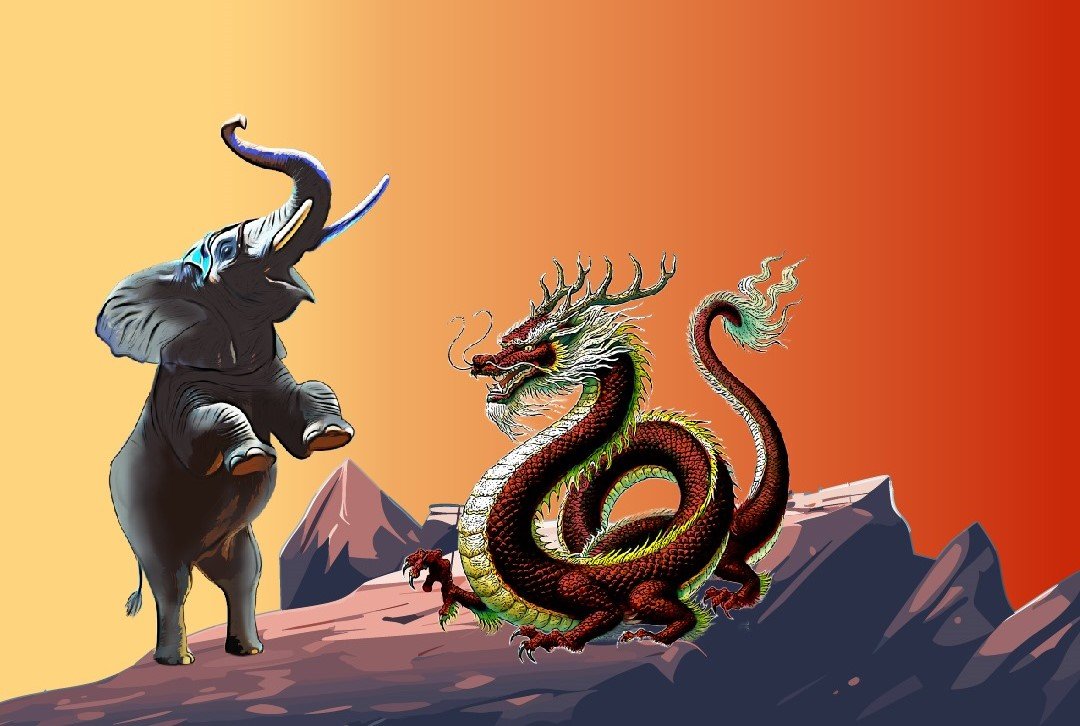India and the Strategic Landscape: India’s rise as a significant global player in the 21st century, marked by its sterling G20 presidency, highlights its growing hard power, soft power, and smart power. A resurgent India shapes its peaceful global ascent marked by promise, potential and performance. Its remarkable economic rise is driven by demographic advantage, rapid digitisation, technology prowess, and expanding diplomatic influence accomplishing its destination of Viksit Bharat 2047. While the path will have to be traversed through multiple external and internal challenges, India’s rise is inexorable.
India’s rise extends far beyond the myopic of just being a counterweight to China. It retains the potential to reshape the geopolitical landscape and offer a peaceful democratic alternative to China’s hegemonic model. Notwithstanding the significant challenges, India appears poised to carve out its developmental course, leveraging its geography, and cultural strengths. This rise promises to rebuild Asia’s strategic landscape in the coming years. India’s trajectory may well hold the key to the future of Asia’s geopolitics and evolving global order.
Viksit Bharat 2047 – The Elephants Footprints
India’s multilateral engagement and multifaceted approach are forging regional stability and emerging global order. India is the fastest-growing economy in the world and is estimated to become a $7 trillion economy – the third largest by 2030. This remarkable growth is driven by a vibrant domestic market, demographic dividend, and advancements in sectors such as information technology, infrastructure, and manufacturing. India is the global leader in digital payments, with one of the highest rates of digital transactions. India’s technology prowess in space technology was showcased in the successful moon mission, exhibiting its capabilities and aspirations as a global technology powerhouse.
India’s commitment to SDG goals and climate change is another keystone of its global preeminence. India is the third-largest producer of renewable energy. To address its demand and balance, the pillars of profitability and sustainability, India has set an ambitious goal of achieving 450 GW of renewable energy capacity by 2030. Initiatives such as the International Solar Alliance and Shakti Sustainable Energy Foundation aim to foster cooperation among solar-rich countries to promote solar energy deployment, advancing national and global policy frameworks for accelerated solar deployment.
India’s multifront diplomatic engagements are characterised by a balanced approach to global issues and the preservation of national interest. As a member of diverse international forums, including the United Nations, G20, BRICS, and SCO, India backs a multipolar world where power is more equitably distributed. India’s active membership in regional forums such as the BIMSTEC and Quad underlines its obligation to regional stability and security
India’s multifront diplomatic engagements are characterised by a balanced approach to global issues and the preservation of national interest. As a member of diverse international forums, including the United Nations, G20, BRICS, and SCO, India backs a multipolar world where power is more equitably distributed. Its active membership in regional forums such as the BIMSTEC and Quad underlines its obligation to regional stability and security.
India’s soft power as represented through her rich cultural, and civilisational heritage and her vibrant diaspora is spread worldwide. It has enabled her to engage in cultural diplomacy, build bridges, foster understanding, and enhance its global image and influence. Educational exchanges further solidify India’s role as a global educational hub and craft a powerhouse of skilled professionals.
The elephants’ footprints in achieving the goals of Amrit Kal are grounded in political stability and addressing all four threats highlighted by Kautilya in Arthashashtra. To emerge as Viksit Bharat, India must bolster its domestic manufacturing and homegrown technology through international collaboration and optimising human capital. Ensuring self-reliance and self-sufficiency, especially in critical domains like defence and emerging technologies, is vital for national security. Further, a focus on innovation, education, and nurturing talent would be key in making India the skill capital of the world.
India’s Strategic Reconstruct: Navigating the Challenge of the Dragon
Strategic Imperatives for India: China’s belligerence, both in the Himalayas and maritime domain, presents a multifaceted challenge for India, containing India’s influence in its neighbourhood and its regional growth. India thus faces strategic concerns regarding defence and economics, prompting a strategic reconstruction in navigating the challenge of the dragon. India must understand the Chinese culture, reposition itself to see India from the Chinese perspective and have a long-term vision for its strategic tools to navigate the dragon. These tools encompass military power, strategic partnerships, multilateral diplomacy, and international economic integration.
India faces strategic concerns regarding defence and economics, prompting a strategic reconstruction in navigating the challenge of belligerent China. India must understand the Chinese culture, reposition itself to see India from the Chinese perspective and have a long-term vision for its strategic tools to navigate the dragon. These tools encompass military power, strategic partnerships, multilateral diplomacy, and international economic integration
Strengthening Military Capabilities: India must continue to modernise its armed forces and develop multi-domain kinetic and non-kinetic capabilities based on a capability-based approach, which would de facto minimise the present and future threats. India’s deterrence requires a strategy of domination-cum-denial rather than reactive defence against China. Its credibility would be a factor of capability-cum-capacity building, including border infrastructure, credible political will, and unambiguous strategic messaging. This calls for a comprehensive strategy that integrates traditional approaches with modern matrices of deterrence and if deterrence fails then defeating the threat. It must be a combination of integrated and balanced deterrence, resilience, and denial-cum-domination to constrain adversaries’ hybrid activities across all domains. At the operational level, it must change its mindset from attritionist force on force to maneouvreist dislocation. India must invest more in disruptive technologies such as artificial intelligence, autonomous systems, unmanned precision systems, quantum technologies, information warfare, cyber warfare and space technology.
Maritime Domain: The Indian Ocean is the centre of major geopolitical competition in the region with China’s growing footprint, India’s growing aspirations and the contest for power in the region between China and the US with its partners. The Indian Ocean sea lines of communication (SLOCs) are important for both India and China for their energy needs and trade. Undersea cables add another dimension. China’s growing hegemony in the Indian Ocean, coupled with its increasing port footprints in the region, poses a security dilemma for India. India’s approach to securing its strategic interests in the Indian Ocean requires a combination of military capability, diplomatic engagement, and economic resilience. India must position itself as a key maritime power in the Indo-Pacific region through indigenous capabilities and multilateral efforts while promoting regional stability and cooperation. The Quadrilateral Security Dialogue (Quad) needs to be leveraged more effectively and made potent.
Economic Resilience and Technological Innovation: India needs to sustain high economic growth rates by fostering innovation and entrepreneurship. Initiatives such as Make in India and Aatmanirbhar Bharat (self-reliant India) should be geared towards creating a robust manufacturing ecosystem. India should gradually reduce its economic dependence on China and adverse balance of trade. This can be achieved by diversifying supply chains, encouraging local manufacturing, and forming trade alliances with other major economies. Investment in research and development, particularly in sectors such as information technology, biotechnology, pharmaceuticals, semiconductors, and renewable energy will be critical in building a self-reliant India and achieving strategic autonomy.
Diplomatic Engagement and Regional Alliances: India must seek strong partnerships with like-minded nations to aid India in enhancing its own economic, technological, and military capabilities, thereby bolstering its ability to become a regional and global power and mitigating Chinese threats. India must harness the power of multilateral institutions to undermine Chinese hegemonic behaviour. Simultaneously, strategic engagement with China in multilateral forums can incentivise Beijing to be more accommodating, furthering India’s diplomatic objectives.
Diplomatically, India must build a coalition of like-minded countries to counterbalance China’s influence. Strengthening ties with ASEAN nations, deepening strategic partnerships with countries such as Vietnam and Indonesia, and engaging with African nations can provide strategic depth. The Asia-Africa Growth Corridor, in collaboration with Japan, is one such initiative that can be expanded. India must stand tall as the voice of the Global South too
Global Connectivity and Coalitions: Strategic projects such as the INSTC, IMEC, IMT trilateral highway, and the development of ports in the Indian Ocean can boost connectivity and counter China’s BRI. Improving connectivity with neighbouring countries through initiatives like BIMSTEC can also enhance regional cooperation and economic integration. Diplomatically, India must build a coalition of like-minded countries to counterbalance China’s influence. Strengthening ties with ASEAN nations, deepening strategic partnerships with countries such as Vietnam and Indonesia, and engaging with African nations can provide strategic depth. The Asia-Africa Growth Corridor, in collaboration with Japan, is one such initiative that can be expanded. India must stand tall as the voice of the Global South too.
Public Diplomacy and Soft Power: Promoting Indian culture, values, and democracy has created a positive image of India on the global stage. India’s soft power through cultural diplomacy, educational exchanges, and global media outreach must help counter China’s narrative. It however needs to be proactive than reactive at present.
Conclusion
As India navigates a complex geopolitical canvas, it will have to further its national interests in the evolving global landscape amidst a belligerent China. By strengthening its military capabilities, fostering economic resilience, enhancing diplomatic engagements, improving infrastructure, and technology prowess, and promoting democratic values, India can navigate these complexities and challenges. These strategies will not only counter China’s influence to constrain India’s growth trajectory but also propel India towards its rightful destination of Viksit Bharat.
-The author is a PVSM, AVSM, VSM has had an illustrious career spanning nearly four decades. A distinguished Armoured Corps officer, he has served in various prestigious staff and command appointments including Commander Independent Armoured Brigade, ADG PP, GOC Armoured Division and GOC Strike 1. The officer retired as DG Mechanised Forces in December 2017 during which he was the architect to initiate process for reintroduction of Light Tank and Chairman on the study on C5ISR for Indian Army. Subsequently he was Consultant MoD/OFB from 2018 to 2020. The Officer is a reputed defence analyst, a motivational speaker and prolific writer on matters of military, defence technology and national security.The views expressed are personal and do not necessarily carry the views of Raksha Anirveda
The author, a PVSM, AVSM, VSM has had an illustrious career spanning nearly four decades. A distinguished Armoured Corps officer, he has served in various prestigious staff and command appointments including Commander Independent Armoured Brigade, ADG PP, GOC Armoured Division and GOC Strike 1. The officer retired as DG Mechanised Forces in December 2017 during which he was the architect to initiate process for reintroduction of Light Tank and Chairman on the study on C5ISR for Indian Army. Subsequently he was Consultant MoD/OFB from 2018 to 2020. He is also a reputed defence analyst, a motivational speaker and prolific writer on matters of military, defence technology and national security. The views expressed are personal and do not necessarily carry the views of Raksha Anirveda






